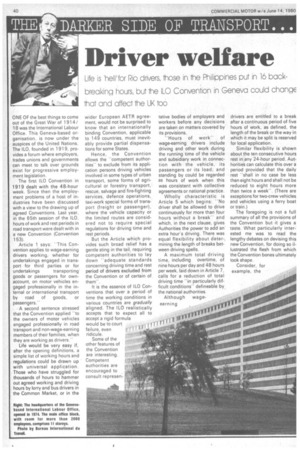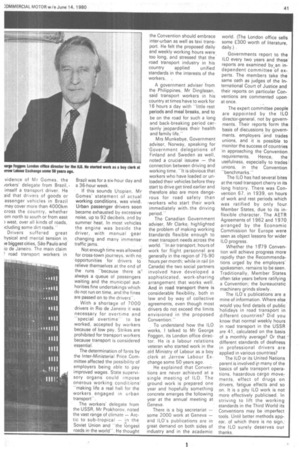Driver welfare
Page 42

Page 43

If you've noticed an error in this article please click here to report it so we can fix it.
Life is 'hell/for Rio drivers, nose in e Philippines put in 16 backbreaking hours, but te ILO Convention in Geneva could changE that and affect e UK too
ONE OF the best things to come out of the Great War of 1914/ 18 was the International Labour Office. This Geneva-based organisation, is now under the auspices of the United Nations. The ILO, founded in 1919, provides a forum where employers, trades unions and governments can meet to talk over grounds exist for progressive employment legislation.
The first ILO Convention in 1 91 9 dealt with the 48-hour week. Since then the employment problems of a host of industries have been discussed with a view to the drawing up of agreed Conventions. Last year, in the 65th session of the ILO, hours of work and rest periods in road transport were dealt with in a new Convention (Convention 153).
Article 1 says: "This Convention applies to wage-earning drivers working, whether for undertakings engaged in transport for third parties or for undertakings transporting goods or passengers for ownaccount, on motor vehicles engaged professionally in the internal or international transport by road of goods, or passengers."' A second sentence stressed that the Convention applied "to the owners of motor vehicles engaged professionally in road transport and non-wage-earning members of their families, when they are working as drivers.'
Life would be very easy if, after the opening definitions, a simple list of working hours and regulations could be drawn up with universal application. Those who have struggled for thousands of hours to hammer out agreed working and driving hours by lorry and bus drivers in the Common Market, or in the wider European AETR agreement, would not be surprised to know that an internationally binding Convention, applicable to 149 countries, must inevitably provide partial dispensations for some States.
Hence, the Convention allows the "competent authorities" to exclude from its application persons driving vehicles involved in some types of urban transport, some forms of agricultural or forestry transport,' rescue, salvage and fire-fighting services, defence operations, taxi-work special forms of transport (freight or passenger), where the vehicle capacity or the limited routes are considered not to require special regulations for driving time and rest periods.
But the Article which provides such broad relief has a gentle sting in the tail, requiring competent authorities to lay down "adequate standards concerning driving time and rest period of drivers excluded from the Convention or of certain of them".
It is the essence of ILO Conventions that over a period of time the working conditions in various countries are gradually aligned. The ILO realistically accepts that to expect all to accept a rigid formula
would be to court failure, even ridicule.
Some of the other features of the Convention are interesting. Competent authorities are encouraged to consult represen
tative bodies of employers and workers before any decisions are taken on matters covered by its provisions.
"Hours of work" of wage-earning drivers include driving and other Work during the running time of the vehicle and subsidiary work in connection with the vehicle, its passengers or its load; and standing by could be regarded as hours of work when this was consistent with collective agreements or national practice.
Wholly characteristic is Article 5 which begins: "No driver shall be allowed to drive continuously for more than four hours without a break" and which, in the next clause, gives Authorities the power to add an extra hour's driving. There was equal flexibility about determining the length of breaks between driving spells.
A maximum total driving time, including overtime, of nine hours per day and 48 hours per week, laid down in Article 7, calls for a reduction of total driving time "in particularly difficult conditionsdefineable by, the national authorities.
Although wage earning drivers are entitled to a break after a continuous period of five hours of work, as defined, the length of the break or the way in which it may be split is reserved for local application.
Similar flexibility is shown about the ten consecutive hours rest in any 24-hour period. Authorities can calculate this over a period provided that the daily rest "shall in no case be less than eight hours and shall not be reduced to eight hours more than twice a week''. (There are exceptions for two-crew vehicles and vehicles using a ferry boat or train.) The foregoing is not a full summary of all the provisions of the Convention but it gives a taste. What particularly interested me was to read the lengthy debates on devising this new Convention, for doing so illustrated the flesh from which the Convention bones ultimately took shape.
Consider, for example, the vidence of Mr Gomes, the eorkers" delegate from Brazil,. imself a transport driver. He aid that drivers of goods or assenger vehicles in Brazil may cover more than 4000,km cross the country, whether om north to south or from east ) west, over all k'nds of roads, icluding some dirt roads."
Drivers suffered great hysical and mental tension in le biggest cities, Sao Paulo and io de Janeiro. The main claim road transport workers in Brazil was for a six-hour day and a 36-hour week.
• If this sounds Utopian, Mr. Gomes' statement of actual working conditions, was vivid.
• Urban passenger drivers soon became exhausted by excessive noise, up to 92 decibels, and by summer heat. In most vehicles the engine was beside the driver, with manual gear changing and many immense. traffic jams.
Not enough time was allowed for cross-town journeys, with no opportunities for drivers to relieve themselves at the end of the runs "because there is! always a queue of passengers waiting and the municipal authorities line undertakings which do not run on time, and the fines are passed on to the drivers".
With a shortage of 7000 drivers in Rio de Janeiro it was necessary for overtime and special overtime" to be worked, accepted by workers because of low pay. Strikes are prohibited for transport workers because transport is considered essential: The determination of fares by the Inter-Ministerial Price Cornmittee affected the possibility of employers being able to pay improved wages. State supervisory organs could impose onerous working conditiOns' "making life a real hell for the 'workers engaged in urban transport".
The workers' delegate from the USSR, Mr Prokhorov, noted the vast range of climate — Arctic to sub-tropical — in the Soviet Union and "the longest roads in the world". He thought the Convention should embrace inter-urban as well as taxi transport. He felt the proposed daily and weekly working hours were too long, and stressed that the 'road transport industry in his country applied unified standards in the interests of the workers. , A government adviser from the Philippines, Mr Dinglasan, said transport workers in his country at times have to work for 16 hours a day with "little rest periods and meal breaks, and to be on the road for such a long and back-breaking period certainly jeopardises their health and family life."
Mrs Munkebye, Government adviser, Norway, speaking for 'Government delegations of Finland and Sweden as well, noted a crucial issuew — the connection between driving and working time. "It is obvious that workers who have loaded or unloaded their vehicles before they start to drive get tired earlier and therefore also are more dangerous for road safety than 'workers who start their work immediately with. the driving period."
The Canadian Government adviser, Mr Clarke, highlighted the problem of making working tandards flexible enough to meet transport needs across the world. "In air transport, hours of work for flight personnel are generally in the region of 75-90 hours per month; while in rail (in Canada) the two social partners involved have developed a sophisticated, work-sharing arrangement that works well. And in road transport there is considerable flexibility, both in law and by way of collective agreements, even though most drivers do not exceed the limits envisioned in the proposed Convention."
To understand how the ILO works, I talked to Mr George Foggon, its London office director. He is a labour relations veteran who started work in the .old Ministry of Labour as a boy clerk at Jarrow Labour Exchange some 50 years ago. .
He explained that Conventions are never achieved at a single meeting of ILO. The ground work is prepared one year and hopefully something concrete emerges the following year at the annual meeting at Geneva.
There is a big secretariat — some 2000 work at Geneva — and ILO's publications are in great demand on both sides of industry and in the academic world. (The London office sells some £300 worth of literature, daily.)
Governments report to the ILO every two years and these. reports are examined by an independent committee of experts. The members take the same oath as judges of the International Court of Justice and their reports on particular Conventions are commented upon at once.
The expert committee people are appointed by the ILO.
director-general, not by govern
ments. Their reports form the. basis of discussions. by govern
ments, employers 'and trades unions, and it is possible to monitor the success of countries in approaching the'Cenvention requirements. Hence, the usefulness, especially to trades unions, in the Convention "benchmarks."
The ILO has had several bites at the road transport cherry in its long history. There was Convention 67, in 1939, on hours of work and rest periods 'which was ratified by only four. Member States, due to its inflexible character. The AETR Agreements of 1962 and 1970. arranged by the Economic Commission for Europe were seen as object lessons for wider ILO progress.
Whether the 1g79 Convention will achieve progress more rapidly than the Recommendations urged by the employers' spokesmen, remains to be seen. Traditionally, Member States often take years before ratifying a Convention; the bureaucratic machinery grinds slowly.
The ILO's publications are a mine of information. Where else. would you find details of public 'holidays in road transport in different countries? Did you know that normal weekly hours in road transport in the USSR are 41, calculated on the basis of a monthly average? Or that different standards of deafness in professional drivers are applied in various countries?
The ILO or its United Nations parent is involved .kri many of the basics of safe transport operations, hazardous cargo move:' ments, effect of drugs on drivers, fatigue effects and so on. It is a pity ILO work is not more effectively publicised. In striving to lift the working standards in the Third World its Conventions may be imperfect tools. until better methods appear, of which there is no sign,' the ILO surely deserves our thanks.
















































































































